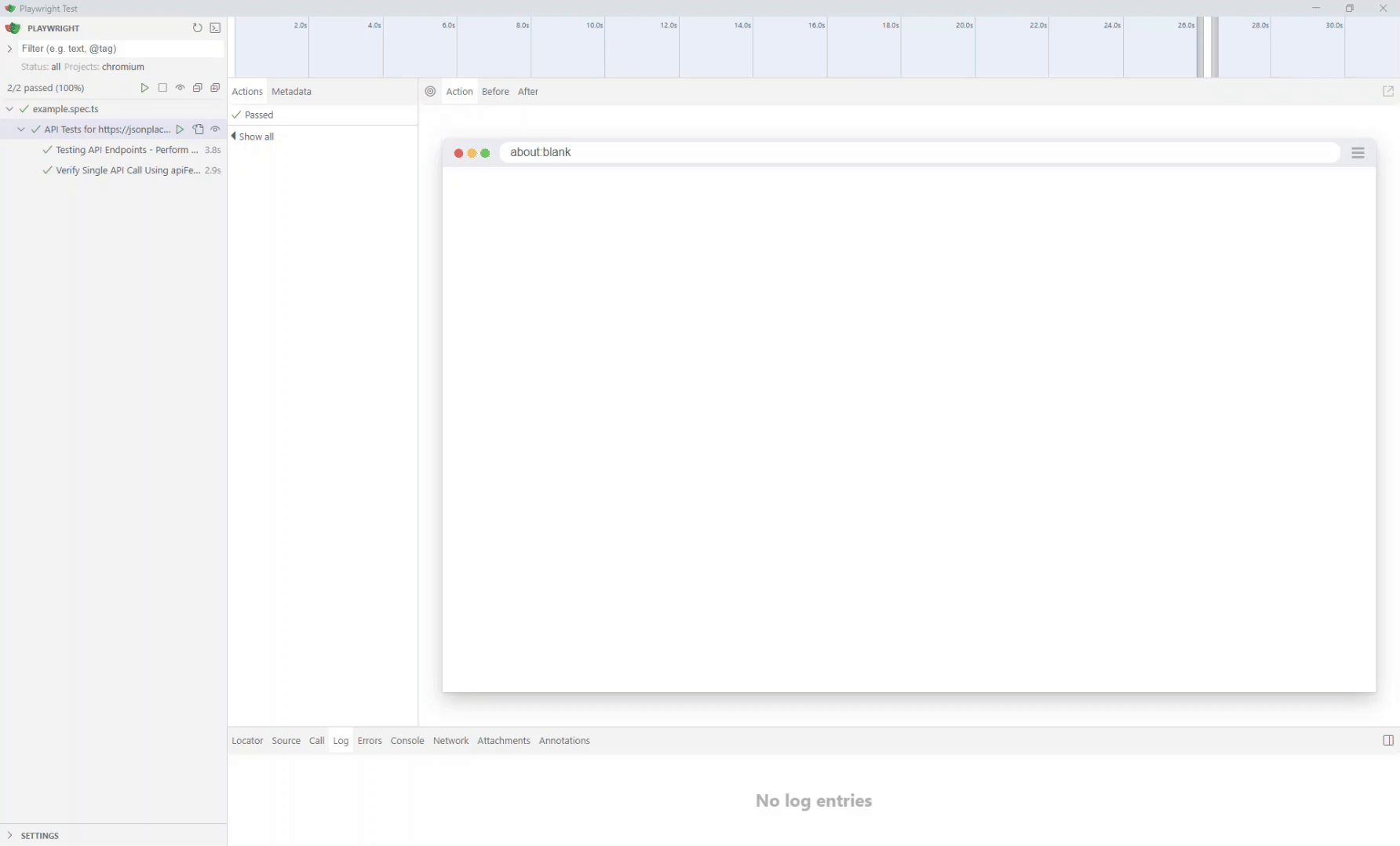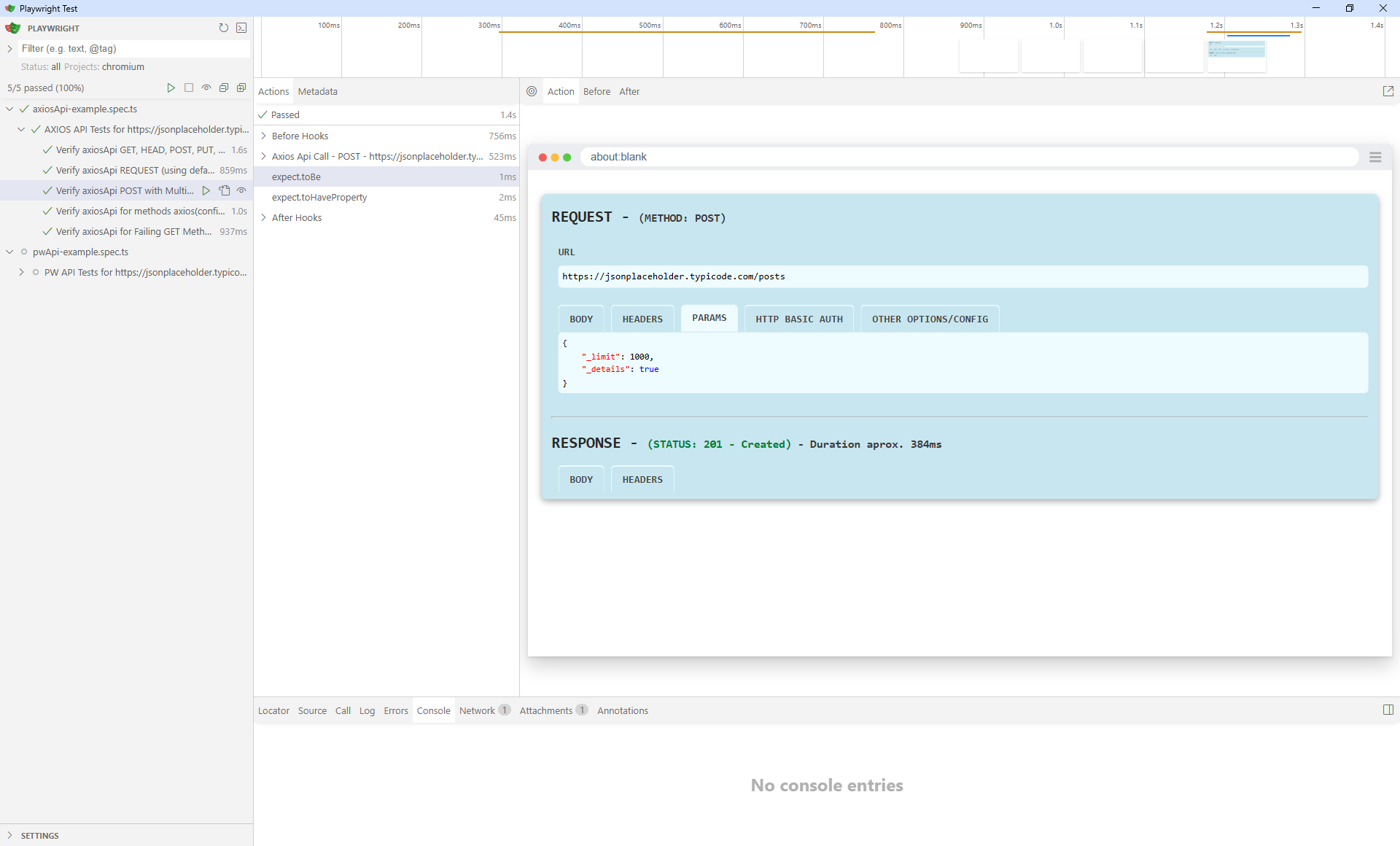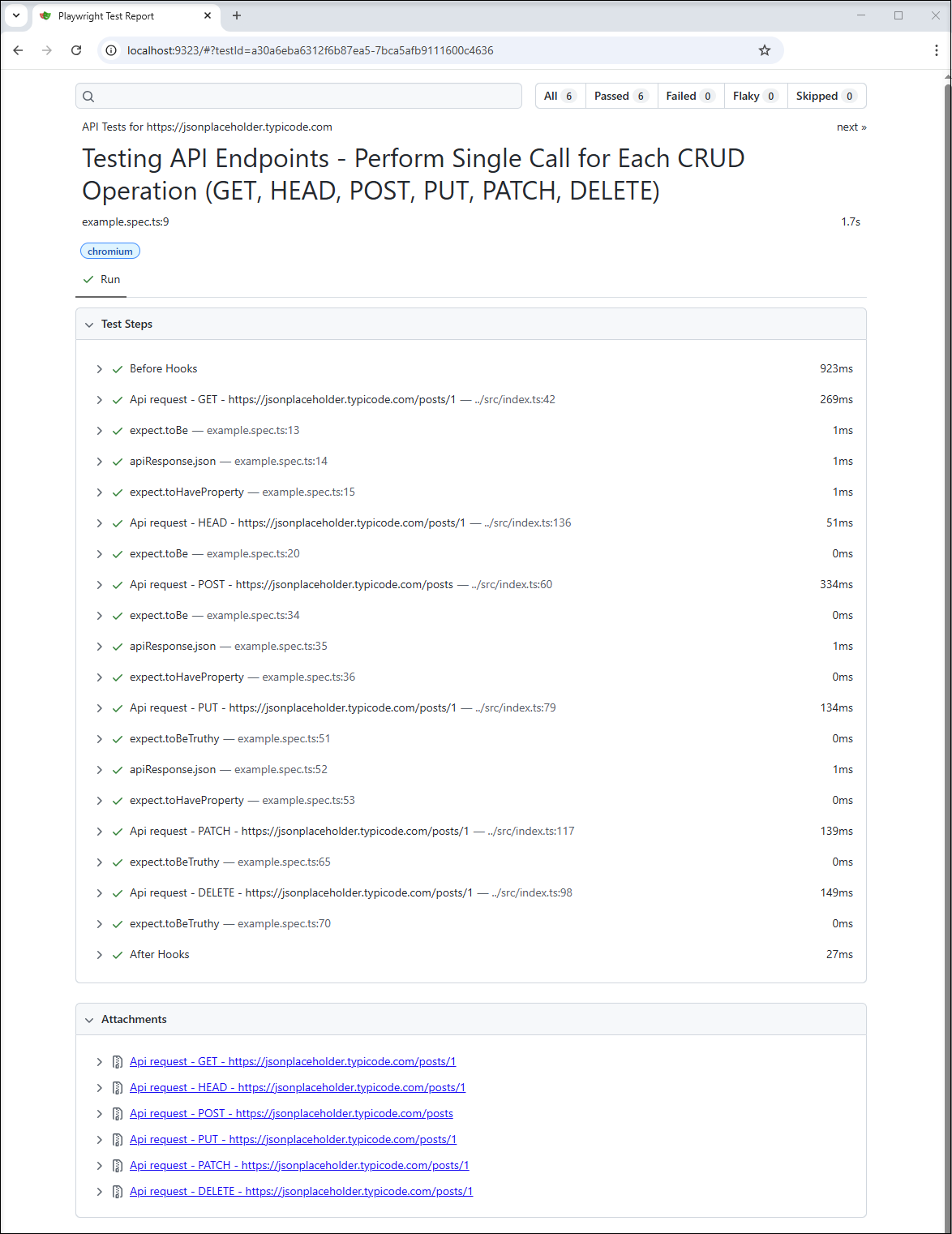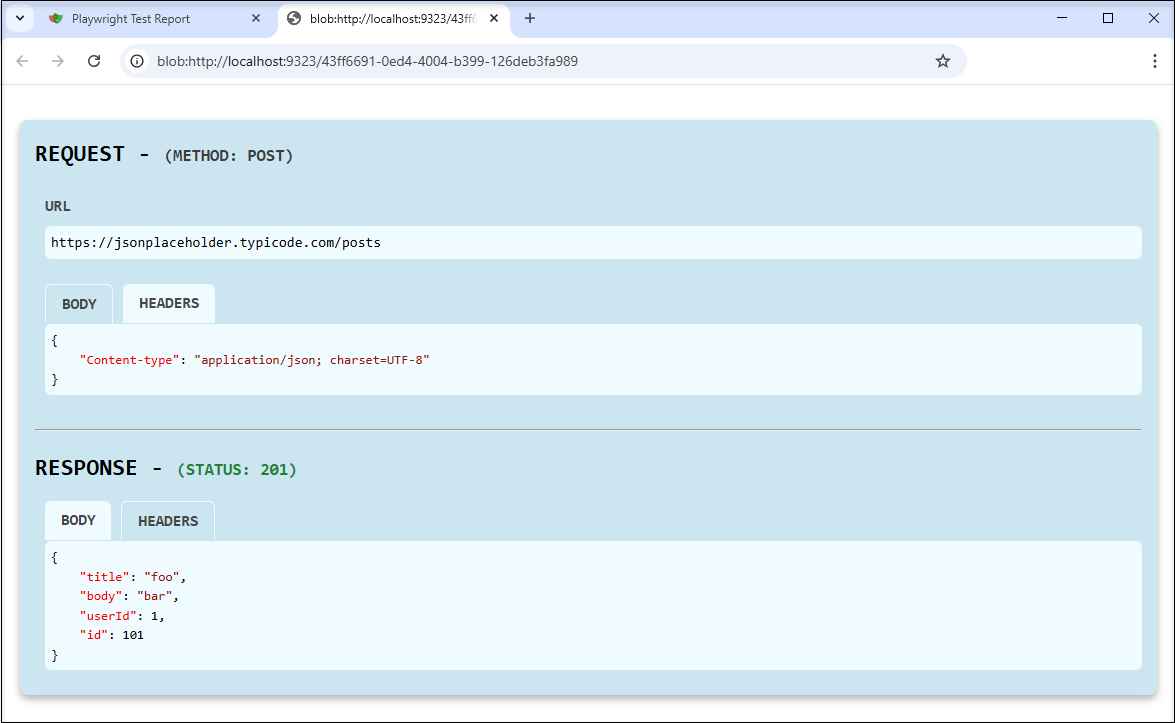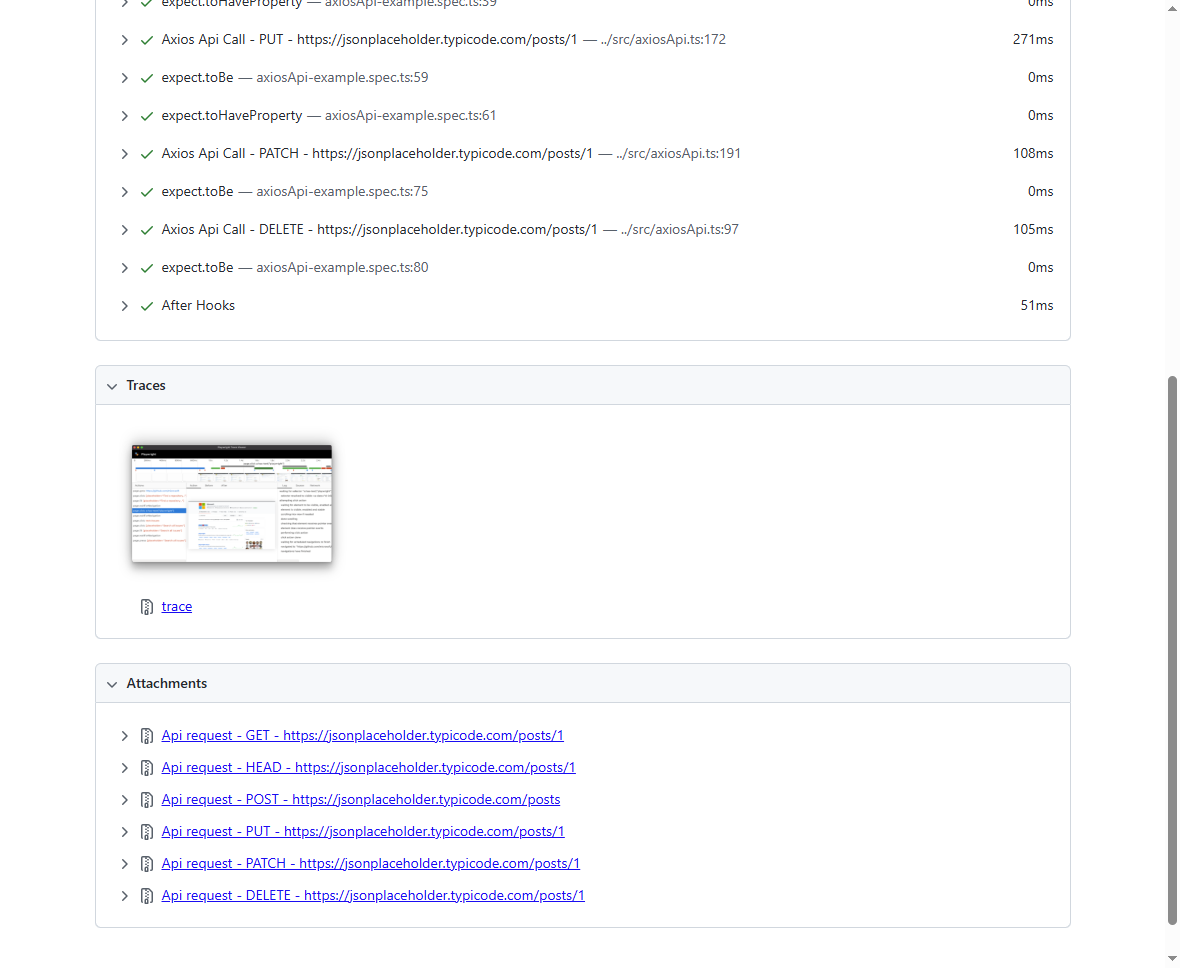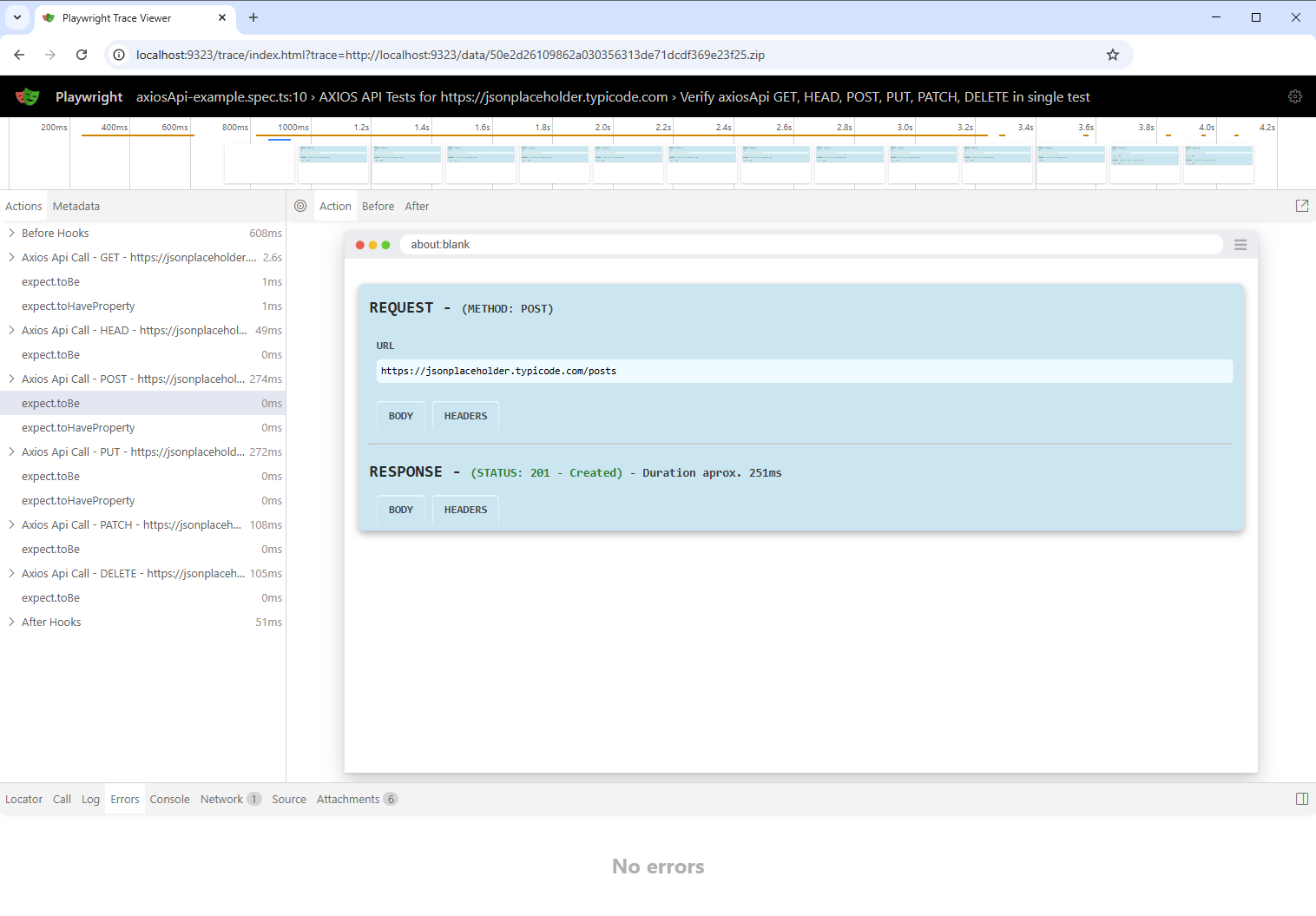Playwright plugin for comprehensive API testing and result presentation using the Playwright UI, Trace Viewer, and HTML Report. It significantly aids debugging processes and supports both Playwright's native API and Axios requests.
-
Lightweight library for Playwright test framework supporting Playwright native API and Axios:
-
Playwright native API - Class
pwApiMethods:
fetch,get,post,put,pPatch,delete, andhead. -
Axios API - Class
axiosApi(Introduced in v2.0.0)Methods :
axios,request,get,post,put,patch,delete,head,options,postForm,putForm, andpatchForm.
-
-
These functions can display detailed API request and response information in the Playwright UI and the Trace Viewer.
-
Each API request and response also can be be included as an attachment in the HTML Report. (Introduced in v1.2.0)
-
The request and response data is presented in tabs to enhance clarity:
-
Request tabs:
Body,Headers,Params,HTTP Basic Auth(axios),Proxy(axios),Functions(axios),Other Options/Config. -
Response tabs:
Body,Headers. -
Environment variables
LOG_API_UIandLOG_API_REPORTto enable the display of API call details in Playwright UI/Trace Viewer, and HTML Report respectively. (Introduced in v2.0.0)
-
-
Supports multiple API calls within a single test, allowing testing multiple endpoints as part of the same test scenario.
-
pw-api-plugin
- MAIN FEATURES
- TABLE OF CONTENT
- INSTALLATION
- CONFIGURATION
-
API REFERENCE
-
Playwright Native API
- ✔️
pwApi.fetch({ request[, page] }, urlOrRequest[, options]) - ✔️
pwApi.get({ request[, page] }, url[, options]) - ✔️
pwApi.delete({ request[, page] }, url[, options]) - ✔️
pwApi.head({ request[, page] }, url[, options]) - ✔️
pwApi.post({ request[, page] }, url[, options]) - ✔️
pwApi.put({ request[, page] }, url[, options]) - ✔️
pwApi.patch({ request[, page] }, url[, options])
- ✔️
-
Axios API
- ✔️
axiosApi.axios({ [page] }, config)andaxiosApi.axios({ [page] }, url[, config]) - ✔️
axiosApi.request({ [page] }, config) - ✔️
axiosApi.get({ [page] }, url[, config]) - ✔️
axiosApi.delete({ [page] }, url[, config]) - ✔️
axiosApi.head({ [page] }, url[, config]) - ✔️
axiosApi.options({ [page] }, url[, config]) - ✔️
axiosApi.post({ [page] }, url[, data[, config]]) - ✔️
axiosApi.put({ [page] }, url[, data[, config]]) - ✔️
axiosApi.patch({ [page] }, url[, data[, config]]) - ✔️
axiosApi.postForm({ [page] }, url[, data[, config]]) - ✔️
axiosApi.putForm({ [page] }, url[, data[, config]]) - ✔️
axiosApi.patchForm({ [page] }, url[, data[, config]])
- ✔️
-
Playwright Native API
- USAGE
- PRESENTATION OF RESULTS
- LICENSE
- CONTRIBUTING
- COLABORATORS
- CHANGELOG
- EXTERNAL REFERENCES
npm install -D pw-api-pluginAdd the following line to your test file:
import { pwApi, test } from 'pw-api-plugin';Include the following line to your test file:
import { pwAxios, test } from 'pw-api-plugin';Class providing methods to make HTTP requests using Playwright native API and log the request and response data on the Playwright UI.
Class function that makes a Playwright FETCH REQUEST to the specified URL and logs the request and response data on the Playwright UI.
-
Parameters:
-
params(Object)-
request(APIRequestContext): The API Playwright request context. -
page(Page): Optional the Playwright page object.
-
-
urlOrRequest(string | Request): The URL or request object to fetch. -
options(optional): Optional fetch options.
-
-
Returns:
Promise<APIResponse>- A promise that resolves to the API response.
Class function that makes a Playwright GET request to the specified URL and logs the request and response data on the Playwright UI.
-
Parameters:
-
params(Object)-
request(APIRequestContext): The API Playwright request context. -
page(Page): Optional the Playwright page object.
-
-
url(string): The URL to send the GET request to. -
options(optional): Optional settings for the request.
-
-
Returns:
Promise<APIResponse>- A promise that resolves to the API response.
Class function that makes a DELETE request to the specified URL and logs the request and response data on the Playwright UI.
-
Parameters:
-
params(Object)-
request(APIRequestContext): The API Playwright request context. -
page(Page): Optional the Playwright page object.
-
-
url(string): The URL to send the DELETE request to. -
options(optional): Optional settings for the request.
-
-
Returns:
Promise<APIResponse>- A promise that resolves to the API response.
Class function that makes a HEAD request to the specified URL and logs the request and response data on the Playwright UI.
-
Parameters:
-
params(Object)-
request(APIRequestContext): The API Playwright request context. -
page(Page): Optional the Playwright page object.
-
-
url(string): The URL to send the HEAD request to. -
options(optional): Optional settings for the request.
-
-
Returns:
Promise<APIResponse>- A promise that resolves to the API response.
Class function that makes a POST request to the specified URL and logs the request and response data on the Playwright UI.
-
Parameters:
-
params(Object)-
request(APIRequestContext): The API Playwright request context. -
page(Page): Optional the Playwright page object.
-
-
url(string): The URL to send the POST request to. -
options(optional): Optional settings for the request.
-
-
Returns:
Promise<APIResponse>- A promise that resolves to the API response.
Class function that makes a PUT request to the specified URL and logs the request and response data on the Playwright UI.
-
Parameters:
-
params(Object)-
request(APIRequestContext): The API Playwright request context. -
page(Page): Optional the Playwright page object.
-
-
url(string): The URL to send the PUT request to. -
options(optional): Optional settings for the request.
-
-
Returns:
Promise<APIResponse>- A promise that resolves to the API response.
Class function that makes a PATCH request to the specified URL and logs the request and response data on the Playwright UI.
-
Parameters:
-
params(Object)-
request(APIRequestContext): The API Playwright request context. -
page(Page): Optional the Playwright page object.
-
-
url(string): The URL to send the PATCH request to. -
options(optional): Optional settings for the request.
-
-
Returns:
Promise<APIResponse>- A promise that resolves to the API response.
Class providing methods to make HTTP requests using Axios API and log the request and response data on the Playwright UI.
Class function that makes an AXIOS API call and logs the request and response data on the Playwright UI.
-
Parameters:
-
params(Object)-
page(Page): Optional the Playwright page object.
-
-
arg1(string | any): Theurlof the API call or aconfigobject containing the Axios request configuration. -
arg2(any): Optional the Axios request configuration ifarg1is a string.
-
-
Returns:
Promise<AxiosResponse>- A promise that resolves to the Axios response.
Class function that makes an Axios REQUEST and logs the request and response data on the Playwright UI.
-
Parameters:
-
params(Object)-
page(Page): Optional the Playwright page object.
-
-
config(any): The Axios request configuration object.
-
-
Returns:
Promise<AxiosResponse>- A promise that resolves to the Axios response.
Class function that makes an Axios GET request to the specified URL and logs the request and response data on the Playwright UI.
-
Parameters:
-
params(Object)-
page(Page): Optional the Playwright page object.
-
-
url(string): The URL to send the GET request to. -
config(any): Optional the Axios request configuration.
-
-
Returns:
Promise<AxiosResponse>- The response from the Axios GET request.
Class function that makes an Axios DELETE request to the specified URL and logs the request and response data on the Playwright UI.
-
Parameters:
-
params(Object)-
page(Page): Optional the Playwright page object.
-
-
url(string): The URL to send the DELETE request to. -
config(any): Optional the Axios request configuration.
-
-
Returns:
Promise<AxiosResponse>- A promise that resolves to the Axios response.
Class function that makes an Axios HEAD request to the specified URL and logs the request and response data on the Playwright UI.
-
Parameters:
-
params(Object)-
page(Page): Optional the Playwright page object.
-
-
url(string): The URL to send the HEAD request to. -
config(any): Optional the Axios request configuration.
-
-
Returns:
Promise<AxiosResponse>- A promise that resolves to the Axios response.
Class function that makes an Axios OPTIONS request to the specified URL and logs the request and response data on the Playwright UI.
-
Parameters:
-
params(Object)-
page(Page): Optional the Playwright page object.
-
-
url(string): The URL to which the request is made. -
config(any): Optional the Axios request configuration.
-
-
Returns:
Promise<AxiosResponse>- A promise that resolves to the Axios response.
Class function that makes an Axios POST request to the specified URL and logs the request and response data on the Playwright UI.
-
Parameters:
-
params(Object)-
page(Page): Optional the Playwright page object.
-
-
url(string): The URL to send the POST request to. -
data(any): Optional the data to send in the POST request body. -
config(any): Optional the Axios request configuration.
-
-
Returns:
Promise<AxiosResponse>- A promise that resolves to the Axios response.
Class function that makes an Axios PUT request to the specified URL and logs the request and response data on the Playwright UI.
-
Parameters:
-
params(Object)-
page(Page): Optional the Playwright page object.
-
-
url(string): The URL to send the PUT request to. -
data(any): Optional the data to send in the PUT request body. -
config(any): Optional the Axios request configuration.
-
-
Returns:
Promise<AxiosResponse>- A promise that resolves to the Axios response.
Class function that makes an Axios PATCH request to the specified URL and logs the request and response data on the Playwright UI.
-
Parameters:
-
params(Object)-
page(Page): Optional the Playwright page object.
-
-
url(string): The URL to send the PATCH request to. -
data(any): Optional the data to send in the PATCH request body. -
config(any): Optional the Axios request configuration.
-
-
Returns:
Promise<AxiosResponse>- A promise that resolves to the Axios response.
Class function that makes an Axios POSTFORM request with 'FormData' to the specified URL and logs the request and response data on the Playwright UI.
-
Parameters:
-
params(Object)-
page(Page): Optional the Playwright page object.
-
-
url(string): The URL to send the POST request to. -
data(any): Optional theFormDatainstance to send as the form body. -
config(any): Optional the Axios request configuration.
-
-
Returns:
Promise<AxiosResponse>- The Axios response object.
Class function that makes an Axios PUTFORM request with 'FormData' to the specified URL and logs the request and response data on the Playwright UI.
-
Parameters:
-
params(Object)-
page(Page): Optional the Playwright page object.
-
-
url(string): The URL to send the PUT request to. -
data(any): Optional theFormDatainstance to send with the request. -
config(any): Optional the Axios request configuration.
-
-
Returns:
Promise<AxiosResponse>- A promise that resolves to the Axios response.
Class function that makes an Axios PATCHFORM request with 'FormData' to the specified URL and logs the request and response data on the Playwright UI.
-
Parameters:
-
params(Object)-
page(Page): The Playwright page object.
-
-
url(string): The URL to send the PATCH request to. -
data(any): Optional theFormDatainstance to send with the request. -
config(any): Optional the Axios request configuration.
-
-
Returns:
Promise<AxiosResponse>- The Axios response object.
The plugin provides two environment variables to control when the details of the API calls are presented to the user:
-
When the environment variable
LOG_API_UIis set to"false", the API request and response information is NOT displayed in the Playwright UI and Trace Viewer in a user-friendly format. By default, these results are shown. -
If the environment variable
LOG_API_REPORTis set to"true", the details of the API request and response are included as attachments in the HTML Report. By default, these results are not attached.
In Playwright, environment variables can be set in the terminal before running the tests.
For example, if you want to display the API request and result details in the Playwright UI or Trace Viewer and include them as an attachment in the HTML Report, simply do the following:
- In PowerShell (there is no need to set
LOG_API_UIto"true"because it is enabled by default).
$env:LOG_API_REPORT="true"
npx playwright test --ui- In Bash.
LOG_API_REPORT="true" npx playwright test --ui- In Batch.
set LOG_API_REPORT="true"
npx playwright test --uiBut if you do not want to display the API request and result details in the Playwright UI or Trace Viewer , you will need to set LOG_API_UI to "false":
$env:LOG_API_UI="false"
$env:LOG_API_REPORT="true"
npx playwright test --uiAnother way to set environment variables in Playwright is by using a .env file in combination with the dotenv package. This approach is useful for managing multiple variables and maintaining consistency across different environments.
Steps:
-
Install the
dotenvpackage:Use the following command to install
dotenv:npm install dotenv
-
Create a
.envfile:Add your environment variables to a
.envfile in the root directory of your project. For example:LOG_API_UI=true LOG_API_REPORT=true
-
Load the
.envfile in your Playwright configuration:Update your
playwright.config.tsorplaywright.config.jsfile to load the.envfile using thedotenvpackage:require('dotenv').config(); const config = { // Your Playwright configuration settings }; module.exports = config;
By following these steps, the environment variables specified in the .env file will automatically be available in all your Playwright tests.
For more information, read the official documentation on Passing Environment Variables.
The library also introduces an extension of the test function, ensuring that the page fixture provided in the test is ignored when the user sets the environment variable LOG_API_UI to "false", resulting in improved performance.
Users can still utilize the standard Playwright test function from @playwright/test. However, including the page fixture in the test may lead to reduced performance, even if the environment variable LOG_API_UI is set to "false". Therefore, it is recommended to use the test function provided by the pw-api-plugin.
To use this, simply include the following in your tests:
import { test } from 'pw-api-plugin';This plugin introduces a new class pwApi, that supports all Playwright native request methods: fetch, get, post, put, patch, delete, and head (that are part of the APIRequestContext class). These methods allow your tests to display the API request and response information in a user-friendly format in both the Playwright UI and the HTML Report.
To utilize these functions, include the following import statement at the top of your test file:
import { pwApi } from 'pw-api-plugin';Since these methods will use Playwright's request fixture and can also display the request and response information in the Playwright UI, they require an object containing the request and page fixtures as the first parameter. The remaining parameters are the same as in the original Playwright request.
For example, if an API call using Playwright's standard get is:
const responseGet = await request.get(`${baseUrl}/posts/1`);Then, using the new pwApi.ge function, the call will be:
const responseGet = await pwApi.get({ request, page }, `${baseUrl}/posts/1`);👉👉👉 IMPORTANT: If you do not want to present the API details in the Playwright UI, you can omit the page and simply pass the request fixture. This approach will make the call more efficient:
const responseGet = await pwApi.get({ request }, `\${baseUrl}/posts/1`);// tests/pwApi-example.spec.ts
import { expect } from '@playwright/test';
import { pwApi, test } from 'pw-api-plugin';
test.describe('PW API Tests for https://jsonplaceholder.typicode.com', () => {
const baseUrl = 'https://jsonplaceholder.typicode.com';
test('Verify pwApi GET, HEAD, POST, PUT, PATCH, DELETE in single test', async ({ request, page }) => {
// ✔️ Example of get
const responseGet = await pwApi.get({ request, page }, `${baseUrl}/posts/1`)
expect(responseGet.status()).toBe(200)
const responseBodyGet = await responseGet.json()
expect(responseBodyGet).toHaveProperty('id', 1)
// ✔️ Example of head
const responseHead = await pwApi.head({ request, page }, `${baseUrl}/posts/1`)
expect(responseHead.status()).toBe(200)
// ✔️ Example of post (with request body and request headers)
const responsePost = await pwApi.post({ request, page }, `${baseUrl}/posts`,
{
data: {
title: 'foo',
body: 'bar',
userId: 1,
},
headers: {
'Content-type': 'application/json; charset=UTF-8',
},
}
);
expect(responsePost.status()).toBe(201)
const responseBodyPost = await responsePost.json()
expect(responseBodyPost).toHaveProperty('id', 101)
// ✔️ Example of put (with request: body, headers, params, timeout, maxRetries)
const responsePut = await pwApi.put({ request, page }, 'https://jsonplaceholder.typicode.com/posts/1',
{
data: {
id: 1,
title: 'foo',
body: 'bar',
userId: 1,
},
headers: {
'Content-type': 'application/json; charset=UTF-8',
},
params: { _limit: 1000, _details: true },
timeout: 2000,
maxRetries: 1
}
)
expect(responsePut.ok()).toBeTruthy()
const responseBodyPut = await responsePut.json()
expect(responseBodyPut).toHaveProperty('id', 1)
// ✔️ Example of patch (with request body and request headers)
const responsePatch = await pwApi.patch({ request, page }, 'https://jsonplaceholder.typicode.com/posts/1',
{
data: {
title: 'hello',
},
headers: {
'Content-type': 'application/json; charset=UTF-8',
},
}
);
expect(responsePatch.ok()).toBeTruthy()
// ✔️ Example for delete
const responseDelete = await pwApi.delete({ request, page }, 'https://jsonplaceholder.typicode.com/posts/1');
expect(responseDelete.ok()).toBeTruthy()
})
test('Verify pwApi FETCH (using default GET)', async ({ request, page }) => {
// ✔️ Example fetch (default GET)
const responseFetch = await pwApi.fetch({ request, page }, `${baseUrl}/posts`);
expect(responseFetch.status()).toBe(200)
const responseBodyFetch = await responseFetch.json()
expect(responseBodyFetch.length).toBeGreaterThan(4)
})
test('Verify pwApi for Failing GET Method (404)', async ({ request, page }) => {
// ❌ Example for get with wrong URL
const responseFetch = await pwApi.get({ request, page }, `${baseUrl}/this-is-a-non-sense-endpoint`)
expect(responseFetch.status()).toBe(404)
})
})This library also introduces a new class, axiosApi, supporting all Axios library request methods: request, get, post, put, patch, delete, head, options, postForm, putForm, and patchForm within the AxiosStatic class. These methods can display API request and response information in the Playwright UI and the HTML Report as attachments.
To utilize these functions, include the following import statement at the top of your test file:
import { pwAxios } from 'pw-api-plugin';Since these methods can display the request and response information in the Playwright UI, they require an object containing the page fixture as the first parameter. The remaining parameters are the same as in the original Axios request.
For example, if an API call using Axios's standard get is:
const responseGet = await axios.get(`${baseUrl}/posts/1`);Then, using the new apiGet function, the call will be:
const responseGet = await axiosApi.get({ page }, `${baseUrl}/posts/1`);👉👉👉 IMPORTANT: If you prefer not to present the API details in the Playwright UI, you can omit the page and instead pass an empty object as the first argument. This approach will make the call more efficient:
const responseGet = await axiosApi.get({ }, `${baseUrl}/posts/1`);// tests/pwAxios-example.spec.ts
import { expect } from '@playwright/test';
import { axiosApi, test } from 'pw-api-plugin;
test.describe('AXIOS API Tests for https://jsonplaceholder.typicode.com', () => {
const baseUrl = 'https://jsonplaceholder.typicode.com';
test('Verify axiosApi GET, HEAD, POST, PUT, PATCH, DELETE in single test', async ({ page }) => {
// ✔️ Example of get
const responseGet = await axiosApi.get({ page }, `${baseUrl}/posts/1`)
expect(responseGet.status).toBe(200)
const responseBodyGet = await responseGet.data
expect(responseBodyGet).toHaveProperty('id', 1)
// ✔️ Example of head
const responseHead = await axiosApi.head({ page }, `${baseUrl}/posts/1`)
expect(responseHead.status).toBe(200)
// ✔️ Example of post (with request: body, headers, params)
const responsePost = await axiosApi.post({ page }, `${baseUrl}/posts`,
{
title: 'foo',
body: 'bar',
userId: 1,
},
{
headers: {
'Content-type': 'application/json; charset=UTF-8',
},
}
)
expect(responsePost.status).toBe(201)
const responseBodyPost = await responsePost.data
expect(responseBodyPost).toHaveProperty('id', 101)
// ✔️ Example of put (with request body and request headers)
const responsePut = await axiosApi.put({ page }, 'https://jsonplaceholder.typicode.com/posts/1',
{
id: 1,
title: 'foo',
body: 'bar',
userId: 1,
},
{
headers: {
'Content-type': 'application/json; charset=UTF-8',
},
params: { _limit: 1000, _details: true },
timeout: 2000,
maxRetries: 1
}
)
expect(responsePut.status).toBe(200)
const responseBodyPut = await responsePut.data
expect(responseBodyPut).toHaveProperty('id', 1)
// ✔️ Example of patch (with request body and request headers)
const responsePatch = await axiosApi.patch({ page }, 'https://jsonplaceholder.typicode.com/posts/1',
{
title: 'hello',
},
{
headers: {
'Content-type': 'application/json; charset=UTF-8',
},
}
)
expect(responsePatch.status).toBe(200)
// ✔️ Example for delete
const responseDelete = await axiosApi.delete({ page }, 'https://jsonplaceholder.typicode.com/posts/1')
expect(responsePatch.status).toBe(200)
})
test('Verify axiosApi REQUEST (using default GET)', async ({ page }) => {
// ✔️ Example fetch (default GET)
const responseRequest = await axiosApi.request({ page }, { url: `${baseUrl}/posts`, params: { _limit: 20000, _details: true }})
expect(responseRequest.status).toBe(200)
const responseBodyRequest = await responseRequest.data
expect(responseBodyRequest.length).toBeGreaterThan(4)
})
test('Verify axiosApi POST with Multiple Request Tabs', async ({ page }) => {
// ✔️ Example of post (with request: body, headers, params, timeout, maxRetries)
const responsePost = await axiosApi.post({ page }, `${baseUrl}/posts`,
{
id: 1,
title: 'foo',
body: 'bar',
userId: 1,
},
{
headers: {
'Content-type': 'application/json; charset=UTF-8',
},
params: { _limit: 1000, _details: true },
timeout: 2000,
maxRetries: 1,
responseType: 'json',
auth: {
username: 'john.wick',
password: 'babayaga'
},
}
)
expect(responsePost.status).toBe(201)
const responseBodyPost = await responsePost.data
expect(responseBodyPost).toHaveProperty('id', 101)
})
test('Verify axiosApi for methods axios(config) and axios(url, config)', async ({ page }) => {
// ✔️ Example of axios(config)
const responseAxios1 = await axiosApi.axios({ page }, { url: `${baseUrl}/posts/1`, params: { _details: true },
validateStatus: (status: number) => status === 200
})
expect(responseAxios1.status).toBe(200)
const responseBodyAxios1 = await responseAxios1.data
expect(responseBodyAxios1).toHaveProperty('id', 1)
// ✔️ Example of axios(url, config)
const responseAxios2 = await axiosApi.axios({ page }, `${baseUrl}/posts/1`, { params: { _getid: true }})
expect(responseAxios2.status).toBe(200)
const responseBodyAxios2 = await responseAxios2.data
expect(responseBodyAxios2).toHaveProperty('id', 1)
})
test('Verify axiosApi for Failing GET Method (404)', async ({ page }) => {
// ❌ Example for get with wrong URL
const responseFetch = await axiosApi.get({ page }, `${baseUrl}/this-is-a-non-sense-endpoint`,
{ validateStatus: (status: number) => status === 404 }
)
expect(responseFetch.status).toBe(404)
})
})To display detailed information about the API calls (request and response) in a user-friendly format in the Playwright UI, you need to ensure the following:
-
Pass the
pagefixture to the pw-api-plugin methods in the object provided as the first argument.-
For Playwright native:
const responseGet = await pwApi.get({ request, page }, 'https/my.api.com/posts/1')
-
For Axios:
const responseGet = await axiosApi.get({ page }, 'https/my.api.com/posts/1')
-
-
Set the environment variable
LOG_API_UIto any value other than"false", or simply leave it unset.
To view detailed information about a specific API call, click on the Actions panel in the page.setContent line or in the assertion located immediately after the API call.
Overview and details of API requests and responses presented in the Playwright UI.
If you are using Axios methods, the card displaying the details of the API call can include additional tabs if such is provided in the config argument, such as HTTP Basic Auth, Proxy settings, and transformation Functions.
Overview and detailed information about API requests in Axios, including additional tabs.
To include detailed information about the API calls (request and response) in a user-friendly format in the HTML Report, you need to ensure the following:
- Set the environment variable
LOG_API_REPORTto"true".
Overview and details of API requests and responses presented in the HTML Report.
By clicking on one of the API attachments, you can display the API call details directly in the browser and interact with the tabs.
Details of an API request, along with its response, are included as an attachment in the HTML Report.
The API results can also be visualized in the Trace Viewer by adding the option --trace=on when running the tests:
npx playwright test --trace=onDetails of an API request, along with its response, are included in the Trace Viewer.
This project is licensed under the MIT License. See the LICENSE file for more details.
First off, thanks for taking the time to contribute!
Special thank you to Mohammad Monfared for his amazing contribution to this plugin. Man you rock!!! 🤟
To contribute, please follow the best practices promoted by GitHub on the Contributing to a project page.
And if you like the project but just don't have the time to contribute, that's fine. There are other easy ways to support the project and show your appreciation, which we would also be very happy about:
- Star the project
- Promote it on social media
- Refer this project in your project's readme
- Mention the project at local meetups and tell your friends/colleagues
- Buying me a coffee or contributing to a training session, so I can keep learning and sharing cool stuff with all of you.
Thank you for your support!
- https://github.com/mmonfared (Mohammad Monfared)
- Fix hover information for public functions.
- Resolve import issue (contribution by Mohammad Monfared).
- Support for Playwright native requests via the
pwApiclass (⚠️ Breaking Change). - Support for Axios requests via the
axiosApiclass. - Support for new request configuration tabs, including:
-
ParamsandOther Options/Config(for both Playwright native and Axios requests). -
HTTP Basic Auth,Proxy, andFunctions(specific to Axios requests only).
-
- New environment variables:
-
LOG_API_UI: Enables or disables the display of API call details in the Playwright UI (enabled by default). -
LOG_API_REPORT: Enables or disables the inclusion of API call details as attachments in reports (disabled by default).
-
- Included in the response the Approximate Duration and Status Text.
- Enhanced API inspection: View detailed information about individual APIs by clicking a specific request in the Actions panel. (Previously, details for the entire list of API calls were shown at the end of a test.)
- Performance improvements.
- Deep reengineering of the core source code for better efficiency and maintainability.
- API requests and results included in HTML report as attachment.
- Group all the actions of the plugin API call within a
test.step()
- Fixed typo in documentation and examples.
- Fixed issue with request body not showing in the tab.
- Added information about response headers.
- Support for tabs in the response and request body/headers to enhance data clarity.
- Fix for an issue where the response does not return a body.
- Full support for Typescript (contribution by Mohammad Monfared).
- Fix depedencies with Playwright.
- Initial release.

